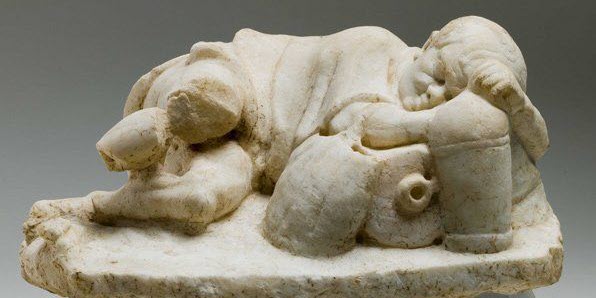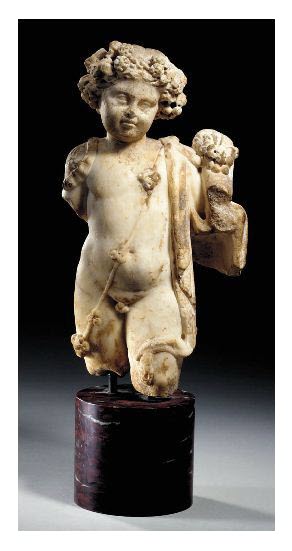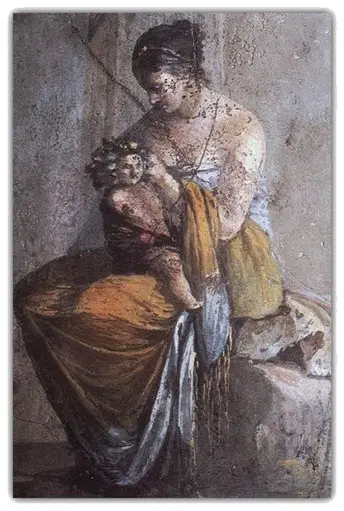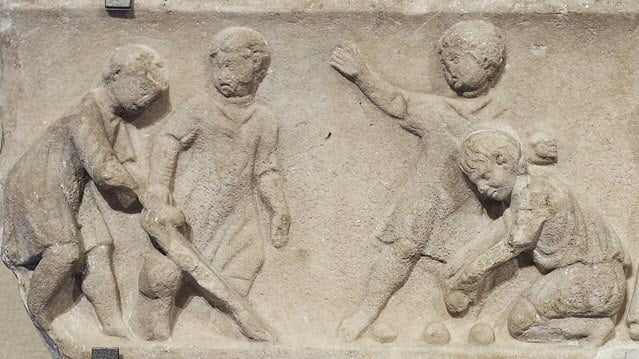
Children in Ancient Rome were treated differently. Their survival chances after birth were heavily determined by their gender and the family’s financial status.
To a newborn, the ways of Rome were not all kind. They were not regarded as human beings until they could talk and walk.
Geographer, Robert Woods, has estimated that about 28% of all infants did not even survive till the age of 12 because of the harsh conditions there were.
The Romans continued this carelessness for children until the 17th Century. The start of industrialization in the 18th Century was when Rome finally started seeing a decline in infant mortality rates.
The initial points seem somewhat jarring. But, there has been enough evidence to support these claims.
Statistics state that only 1.3% of burials for infants have tombstones. It goes to show that Romans were negligent towards their children.
However, that did not mean that they did not feel joy at the birth of a child. One of the carvings found in a residential neighborhood read: ‘Iuvenilla is born on Saturday the 2nd of August in the second hour of the evening.’, with a charcoal illustration of a newborn next to it.
These carvings show that even if mortality rates were so high, parents still loved their children in at least one aspect of their lives.
Childbirth in Rome
Content

When a child was born and survived birth, the child would be placed on the floor. The para familias (the oldest living man of the house) would determine if the child should be accepted into the family or condemned. If the para familias lifted the child off the ground, it meant ceremonial acceptance into the family. And, simply turning away meant condemnation.
Infanticide was considered permissible in Ancient Rome. The practice was significantly more common among impoverished families, as they could not afford to raise children, especially daughters.
However, not every child condemned by their families was sentenced to death. Infants who were abandoned along the streets of Rome were picked up by enslaved people to be raised into the life of slavery.
While they could avowedly evade such a life, doing so necessitated substantial evidence of their Roman citizenship, which was unfeasible.
Adoption was also prevalent in patrician Rome. The process was done more so to ensure the progression of the family line than doing the deed of providing shelter to these children.
Romans from the aristocratic society correlated the continuity of their family line to social status and power compared to the plebeians.
While all the points mentioned above stand to display the uncaring nature of Roman upbringing, some practices were pragmatic to behold as well. The birth of a Roman was always registered.
According to J.N. Adams, “Romanitas and the Latin Language,” an old birth certificate read, “To the clerks of the metropolis, from Ischyras… and his wife, Thaisarion… We at this moment register the son, Ischyras, born to us and being one year of age in the current 14th year of the emperor Antoninus Caesar”.
Life after childbirth
The births of accepted newborns were only celebrated about a week after they were born due to high infant mortality rates.
This celebration was chiefly known as the dies lustricius, or “day of lustration’, the ritual purification performed on the eight-day after the birth of a girl or the ninth day after the birth of a boy.
This was when the child would be given a name, which would mark the official acceptance into the family.
The first-born male children often received their Father’s name; Lucius Annaeus Seneca, for example, was named after his father, Lucius Annaeus Seneca.
Male children born after that were called from the minimal number of Roman first names, or Praenomen. The characters were characterized into 3 parts.
The Praenomen (personal name), the Nomen (family name), and the Cognomen (family identifier), while the girls were only given the feminized version of the Nomen.
During this ritual, the child was given a bulla, a protective amulet, traditionally regarded as a protective charm to ward off evil eyes. These amulets were indubitably bestowed upon the boys, and the answer to whether or not it was the same for girls, remains unknown.
Both boys and girls, as young children, would wear Roman invented white, purple-rimmed Toga with a purple border in public. This was done to distinguish them as youth in need of protection.
Raising of a newborn in Ancient Rome

Children from affluent families were assigned a wet nurse. There were various reasons why this was done so.
The mother may not have been able to produce milk, she may have had the desire to conceive again shortly after childbirth, may have died in childbirth, or wished to maintain her feminine figure.
Breastfeeding was considered to age a woman prematurely but was simultaneously seen as a crucial step in raising a child. One’s values and righteousness were traditionally seen to be conveyed from the milk.
Hence, since wet nurses were often either enslaved people or extremely poor themselves, the child raised under their care were deemed evil.
Thus, this became a subjugation tool for the Romans of the older generations to lament the youth of their moral flaws.
In their youth, babies were swaddled to give them the optimal form. Doing so would encourage right-handedness and the proficiency of other general body manipulation.
For example, if the baby’s nose were deemed too flat, it would be pinched to give it a sharper form.
This practice was customary, as it was regarded as an essential step that would mold their shape to provide an ideal body that would draw them up for adulthood.
Infancy in the Roman world lasted until 7, which marked the legal age of a child’s baby teeth falling out. Before this age, childcare was heavily focused within the house.
Depending on the family’s wealth, a nurse would be provided for the children. Theories on child care varied then, as much as they do now.
The nurses took a remarkably maternal role in the child’s life, developing a deep bond throughout their life. They offered a womanly perspective on child-rearing.
Similarly, their male counterparts, Pedagogy, were typically enslaved people or freedmen who took on the same role as the nurses, teaching the child cultural etiquettes and being a good Roman.
Meanwhile, most children from the less fortunate families were brought up directly by their immediate family members as they could not hire external help.
Life After Infancy

After the rigorous process of growing up and becoming a walking, talking person, Roman children would finally start being treated as proper humans.
They did love their kids immensely, as they believed children were born soft and weak. So, they made it their duty to see that their kids were molded into adults properly.
Roman parents would often engage in practices like corporal punishment, immobilizing newborn infants on wooden planks to ensure proper growth, and bathing them in cold water to prevent them from succumbing to the “softness” they would otherwise impart from soaking in warm water.
The children were very reliant on their parents, especially their Father. Even their clothing came from the adults in the house until they came of age or were married.
A child in Rome was educated in their home, and when they were not learning, they would be playing.
The children used to play with various toys such as rattles, dolls made of cloth, clay, wax, toy weapons, letter blocks, tops, balls, and hoops made of sticks. The children were also amiable and playful with dogs.
Both parents would be involved in the process in terms of education and training. The focus was more on moral development rather than intellectual; their respect for the gods, the Roman law, their loyalty towards authority, and integrity were the essential virtues for the parents to teach their children.
Most of the training came from the children’s constant association with their parents. This was the characteristic feature of the Romans’ home training, compared with that of other people of early days.
When it came to family time, the children would sit with their elders in time of eating and would also help to serve the meals.
Roman mothers would be the teacher for the children. They taught them to speak adeptly in their native tongue and the elements of literacy, which went as far as teaching them arithmetically.
Life of a teenager in Ancient Rome

Entering teenagehood was considered an important milestone, as it signified a vital step into manhood and their womanhood for the girls.
The boys were given the education that corresponded with their class. Those of the upper class were groomed to be military, law, or religious. Patrician boys were taught oratory and rhetoric, the necessary skills to progress into power.
On the other hand, the girls were raised to take on a maternal role. They were taught to oblige to their parent’s will, and later on, their husband’s.
Without being given a choice, it was their Father who would find them a husband, and more often than not, the marriage was sculpted around the basis of financial gain, power, privilege, and building business relationships.
On their wedding night, the girls would leave their bullas at the altar of their household gods and burn their toys, putting an end to their childhood. They would then go on to fulfill the role of a Roman Matrona.
Education in Rome was not free and readily accessible. As a result, families would hire private tutors who have typically educated Greeks to teach their children.
The girls were included in the education up until their adolescent years. Education after that was considered redundant, as they had to learn from their mother about their next role, adulthood.
Conclusion
Despite the rite of passage for infants being so tricky, Roman parents were still supportive and caring of their kids to some extent, at least for that period.
Though there were a lot of hardships that they had to go through, Roman children still received good support from their parents.
And they lived a fulfilled life in terms of education and recreation as their parents would ensure to nurture them well, raising them to be good men and women for that period’s context.
